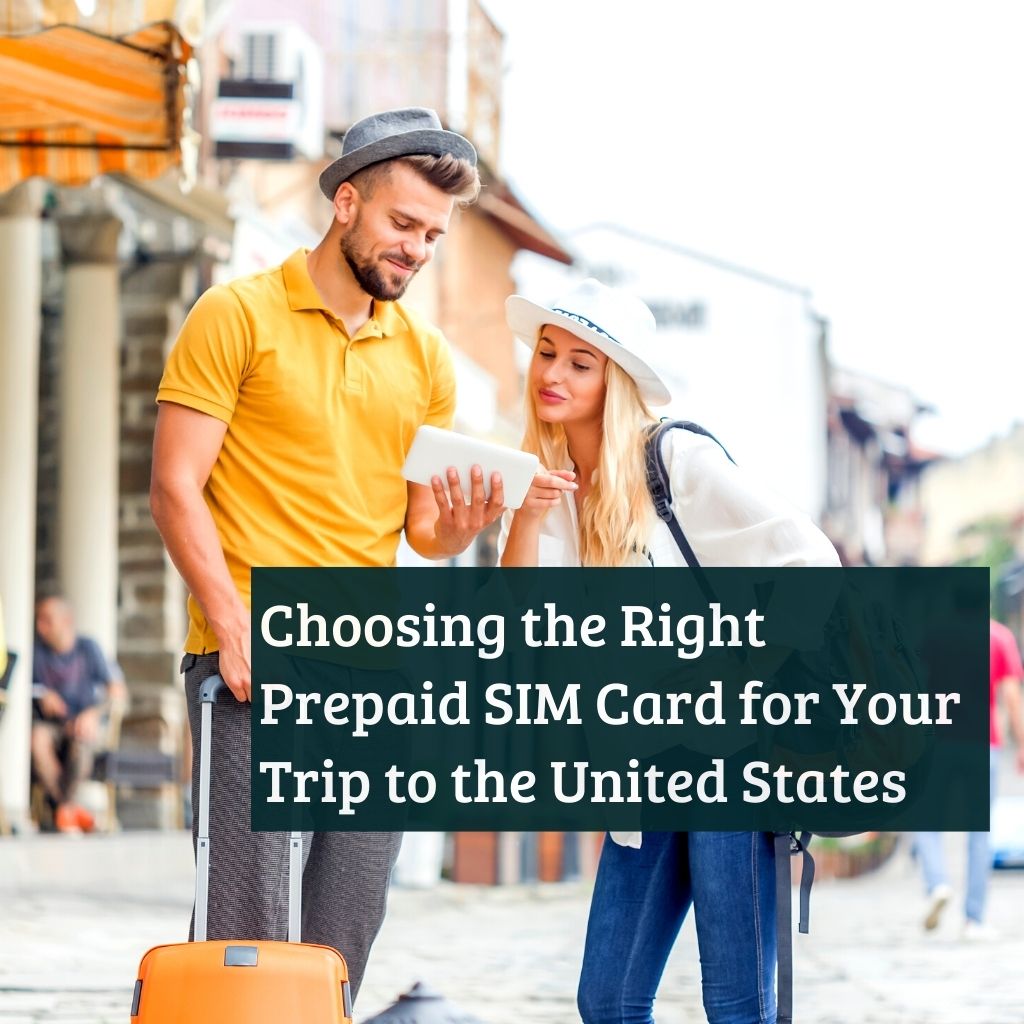The United States is one of the top 5 most expensive countries for international roaming, according to WorldSIM. This means that if you want to stay connected while visiting the United States, you’ll need a local SIM card.
The United States is also one of the most expensive countries in the world to use mobile phones. You must also pay to receive calls. The country is among the most expensive in the world for mobile data, ranking fourth.
Don’t lose heart!

In the United States, there are ways to save money (a lot of money) by using prepaid mobile services. When selecting a prepaid SIM card for travel to the United States, there are a few factors to consider. Let us unravel the complexities and navigate through the current situation.
1. Cellular networks in the US
The United States has primarily two types of cellular networks: GSM and CDMA. Verizon Wireless, the largest telecom operator in the United States and Sprint, operate on a CDMA network. Verizon has, however, begun decommissioning the CDMA network, which is expected to be completed by the end of 2022.
Because GSM networks are used by more than 80% of mobile users worldwide, it is very likely that your phone will not work with Verizon Wireless until at least 2022. If you’re traveling to the United States with a GSM phone, you’ll want to get a prepaid SIM card that will work on your phone.
2. An overview of US telecom carriers
There are four major national wireless carriers in the United States: Verizon, AT&T, T-Mobile, and Sprint (now acquired by T-mobile). Each carrier has its own prepaid offerings, which can be confusing for consumers.
The prepaid plan costs between $10 and $65 per month. The cheapest plan includes the least amount of data and minutes. As an example, a $10 T-mobile prepaid plan includes 1,000 minutes & 1,000 texts and up to 1 GB of data, while a $25 plan offers unlimited talk & text and up to 6 GB.
What exactly is a ‘minute’? You have never heard of it? Welcome to the United States!
Here, most mobile plans charge by the minute. This means that you are charged a set rate for each minute you use your phone for both receiving and making calls. You get a bundle of free minutes with each plan. Once you exceed your bundle, you will be charged an additional fee. The rate varies depending on your carrier and plan but is typically around $0.10 per minute.
Most minutes plans also include a certain amount of data, which you can use to surf the web or check email. Again, an additional fee applies once your data limit is exceeded or your speed is significantly reduced.
3. Mobile Virtual Network Operator (MVNO)
MVNOs are wireless communications service resellers. They lease wireless capacity (purchase minutes and data) at wholesale prices from a national telecom carrier and resell it to consumers at lower retail prices under their own business brands.
Mostly all the MVNOs in the US offer only prepaid plans. They are a great choice for buying local prepaid SIM cards if you’re looking to save money. As of today, there are 139 MVNOs in the US serving 36 million customers.
3.1 Why MVNOs over national carriers?
There are several reasons why prepaid MVNOs may be a better option than prepaid plans from the national carriers.
- You can choose from a diversity of plans based on your exact need. “Talk” only, “Data” only, or Hybrid.
- The plans are at least 25% cheaper. Unlimited plans are at least 50% cheaper.
- Instant activation
- If you only intend to use the phone for emergencies or select occasions, they offer a Pay-as-you-go plan with higher validity. The plan starts as low as $10 for 90 days.
- Free international calling to 50+ countries, free roaming in Canada and Mexico, and additional credit to make international calls to countries not covered by free international calling.
- Free international text (SMS) to anywhere in the world.
- So that you can make a well-informed decision, every MVNO discloses which national carrier’s network it uses.
3.2 Do they have stores? Why can’t I find them easily?
Because MVNOs have little to no retail presence, many travelers are unaware of them. They do not spend a lot of money on advertising. They keep their operating costs extremely low to provide you with a more cost-effective prepaid plan than national carriers. Whereas thousands of retail stores for T-Mobile, AT&T, and Verizon can be found in almost every mall and downtown street.
- A large portion of their business comes online.
- Their retail partners include small mobile repair shops and accessory retailers.
- MVNO SIM cards are available for $0.99 on eBay with free delivery from hundreds of sellers. Why do they sell so cheaply? As soon as you purchase a plan, they receive a commission.
3.3 The downside
They are very much no-frills. It’s like the difference between flying Singapore Airlines and AirAsia.
- You can’t walk into a store and fix your problem
- Getting one-on-one customer support will be difficult
- Phone support will have a longer wait time
- Network deprioritization – slower speed and call drops. (this is a myth as I have never experienced this)
- It doesn’t work outside the US (no international roaming)
- Failure to recharge your plan will result in the loss of your number in 30 days
3.4 Popular MVNOs in the United States
- America Movil
- H2O Wireless (I have used it extensively)
- Google Fi
- Cricket Wireless
- Boost Mobile
- Mint
- Simple Mobile
3.5 MVNOs with eSIM
- H2O
- RedPocket
- PureTalk
eSIM is available on all national carriers.
Note: eSIM is only available on selected high-end Smartphones. Check the compatibility before taking off.
3.6 Plan comparison
Budget Plans
| T-mobile | AT&T | Verizon | H2O | Google Fi | Simple Talk | |
| Plan | $10 | $18 | $25 | |||
| Minutes | 1,000 | Unlimited | Unlimited | |||
| Data | 1 GB | 2 GB | 3 GB | |||
| Benefits | Unlimited calling to 70 countries $1.5 international talk credit | Unlimited calling to 69 countries $10 international talk credit Free roaming in South America | ||||
| Validity | 30 days | 30 days | 30 days |
Mid-range Plans
| T-mobile | AT&T | Verizon | H2O | Google Fi | Simple Talk | |
| Plan | $40 | $40 | $35 | $36 | $20 | $40 |
| Minutes | Unlimited | Unlimited | Unlimited | Unlimited | Unlimited | Unlimited |
| Data | 10 GB | 15 GB | 15 GB | 15 GB | 10 GB | 15 GB |
| Benefits | Free roaming in Canada & Mexico | Unlimited calling to Canada & Mexico | Unlimited calling to 70 countries $5 international talk credit | Unlimited calling to Canada & Mexico | Unlimited calling to 69 countries $10 international talk credit Free roaming in South America | |
| Validity | 30 days | 30 days | 30 days | 30 days | 30 days | 30 days |
Unlimited Plans
| T-mobile | AT&T | Verizon | H2O | Google Fi | Simple Talk | |
| Plan | $50 | $50 | $50 | $45 | $65 | $40 |
| Minutes | Unlimited | Unlimited | Unlimited | Unlimited | Unlimited | Unlimited |
| Data | Unlimited | Unlimited | Unlimited | Unlimited | Unlimited | Unlimited |
| Benefits | Unlimited calling to Canada & Mexico Free roaming in Canada & Mexico | Unlimited calling to Canada & Mexico | Unlimited calling to 70 countries $5 international talk credit $10 roaming credit to Canada & Mexico | Unlimited calling to to 50 countries Free international data roaming | Unlimited calling to 69 countries $10 international talk credit Free roaming in South America | |
| Validity | 30 days | 30 days | 30 days | 30 days | 30 days | 30 days |
I hope this helps…
Prepaid SIM cards are an excellent choice for travelers to the United States because they provide flexibility and peace of mind. With so many providers and plans to choose from, it can be difficult to know which one is right for you. I hope this guide has helped you understand the various types of prepaid SIM cards available in the United States and has facilitated you in selecting the best option for your needs.





Hi Turuhi
planning to visit alaska for 4 days . just wanted to check if it is ok to buy a prepaid sim that can be used for 2 weeks for Data usage
can i buy one from seattle?
Yes, you can.